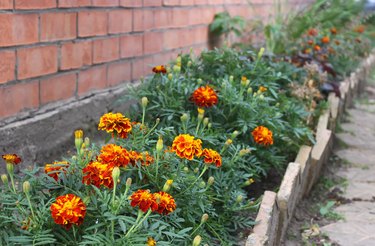
Marigolds (Tagetes spp.) are well known for repelling pests, but they aren't immune to bug infestations. Common insects that enjoy snacking on these flowers include slugs, snails, aphids, and thrips. If you notice insects eating your marigolds, the first step to eliminating the problem is identifying the pests so you can then find the right way to kill them.
Slugs and Snails
Video of the Day
Two of the most common pests that eat marigolds are slugs and snails. You might occasionally see them on your plants in the daytime after it rains, but because these pests typically only come out at night, you are more likely to see their trademark slime trails on or around your plants during the day.
Video of the Day
To eliminate these slimy troublemakers in your garden, start by picking them off the plants by hand and dropping them in soapy water. You'll need to target them at night or early in the morning while they're out eating your plant. If you don't want to go slug and snail hunting, try placing a coffee can in a hole near your plant so the top of it is level with the ground. Then, add beer to the can to attract these slimy pests since they are both attracted to fermented foods. Slugs and snails will climb into the beer and then drown since they can't climb out of it. Alternatively, adding eggshells and nut hulls to the mulch around your marigolds may help keep these soft-bellied pests at bay.
While you can also kill slugs and snails with salt, it's best to avoid putting salt in your planters or garden soil because it can harm your plants.
Aphids and Ants
Aphids aren't particularly picky pests, so they aren't put off by the strong scent of marigolds and may suck the sap from the leaves and stems. The sweet honeydew that aphids leave behind also attracts ants, which may not directly harm your plants, but ants help to protect aphids from predatory insects and may spread diseases to your plants. Signs of aphids include the leaves turning yellow and curling, stunted growth, and the presence of ants. You may also see the aphids themselves, which are small insects that may be yellow, green, red, brown, or black in color.
To manage an aphid infestation, spray them off your plants with a steady stream of hose water multiple times a week. You can also apply insecticidal soap to the plants, which will kill these pests on contact. Insecticidal soap may also kill beneficial insects, like ladybugs, that happen to be on the plant when you spray, but these soaps don't leave residual toxins behind so they don't harm insects that land on the plant after you've sprayed.
Thrips on Marigolds
Thrips' modus operandi is piercing plant tissue and sucking out the contents of the cells, which may stunt a plant's growth or even kill herbaceous plants like marigolds if they attack in sufficient numbers. These insects are often too small to see, but if you have one of the larger varieties in your garden, you may notice small winged white, yellow, brown, or black insects on your plants. Signs of thrip damage include premature leaf drop, tiny black specks of thrip excrement, and yellow, silver, or white streaks or spots on plant leaves or stems.
To control thrips, spray the plants with a ready-to use neem oil product according to the manufacturer's directions. Be sure to apply the spray late in the evening or early in the morning to minimize harm to pollinators and other beneficial insects.